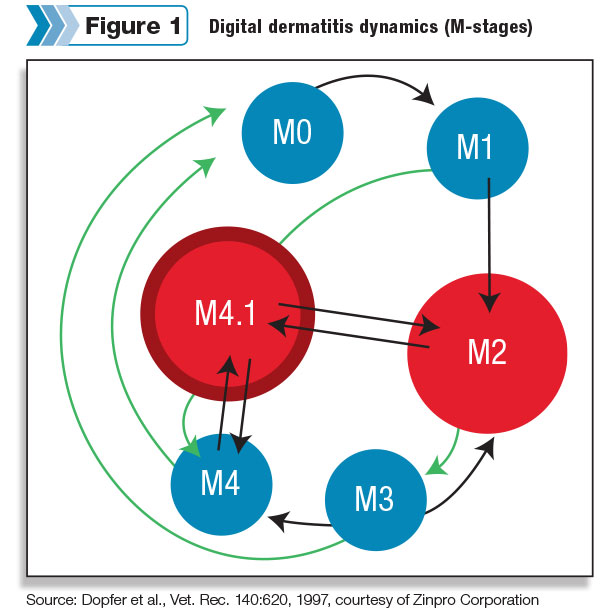Digital dermatitis (DD) infections are a common sight on confinement dairies, often ailing more than 20 percent of cows in a herd, but there are ways to reduce the incidence of these painful lesions that lead to limping and lameness.
According to Nigel Cook from the University of Wisconsin – Madison’s Dairyland Initiative, a strategy to take on the detrimental effects of DD includes five key areas:
- Understanding the cycle of the infection
- Focusing on heifers
- Increasing surveillance
- Treatment
- Prevention and control
“This is how we defeat – not eliminate – digital dermatitis in our dairy herds,” Cook says.
Understanding the cycle of the DD infection
Contrary to the common name “hairy heel warts,” a DD lesion is really not a wart at all. In fact, the bacteria that penetrates into the cow’s skin to cause the infection is related to the species of treponeme bacteria that also causes “udder rot” and human periodontal disease.
DD does its dirty work by breaking down the top-level barrier of skin protection, the epidermis. Cows that spend 12 hours a day or more with their feet in manure are particularly susceptible to the bacterial infection, which can be visibly seen as a small lesion on the foot, classified as an M1.
Cook explains that an M1 will either spontaneously cure or progress to an M2 lesion, which is around 20 mm in diameter. As it becomes an M3, it goes through a healing stage; however, the bacteria can destroy the ability of the cow’s cells to regrow normal-looking tissue. “That’s when we see crazy proliferation,” Cook notes (photo above).
Left untreated, the M3 lesion can develop into a chronic, nearly incurable M4 that will heal but then come back as an M2 when the cow’s immunity is compromised. Therefore, the best chance for successful treatment of the lesion is at the M2 stage, before it can advance to an M3 or M4.
Focus on heifers
DD infections can be detrimental to a heifer’s reproduction and performance. One study showed a 740-pound difference in first-lactation milk between heifers with multiple DD infections and those without. First conception to A.I. was also significantly different (42 percent versus 29 percent). “The focus has to be starting with the heifers … walking pens, looking at heels, finding lesions,” Cook explains.
Surveillance
Cook emphasizes that surveillance must be done deliberately in order to effectively catch DD cases and accurately identify their stages. Only observing at the dry-off trim is not sufficient. “Weekly surveillance is good,” he says, “but monthly is not enough.”
He recommends observing cows in a convenient area like at the bunk or in the parlor, where the feet are visible. When lesions are observed, they should be recorded and labeled according to their stage.
This is important because an M2 lesion can be treated and cured, but an M4 lesion is not likely to show improvement. “We will have a much better chance of cure if we get to them before proliferation [M4],” Cook adds.
Treatment
While there are no treatments labeled specifically for DD, oxytetracycline is often the go-to drug for these lesions. While this application is considered extra-label drug use, it has shown to be one of the more effective treatments available.
For a DD treatment, oxytetracycline powder is applied to the affected area, sometimes with a bandage to hold it in place for just a few hours. It is important that the bandage be removed or allowed to fall off.
Also, when the trimmer uses a knife to scrape the affected area, they must be careful not to worsen the lesion. Reducing trauma – not increasing it – is the goal, Cook explains.
Prevention and control
-
Footbath: Regular use of a footbath can hold DD in check, having its greatest success against lesions in their early stages. Cook warns, however, not to overdo it. Start off with three to four days a week, look at the records and adjust the frequency accordingly. If you are seeing proliferation with M4 lesions, the footbath may be too aggressive and need the concentration adjusted.
-
Organic trace minerals: Cook further notes that feeding organic trace minerals to enhance immunity has been shown to reduce the severity of DD infections among cows and suggests a proactive approach with heifers as well.
-
Hygiene: Improving the cleanliness between claws creates an environment where DD is less likely to thrive. On an infected foot, the cleft between the toes grows deeper and fills with manure, thus creating an ideal situation for the disease to flourish.
Trimming can help to improve foot hygiene, and dairies should consider strategic scraping schedules to avoid cows standing in pooled manure. PD
This presentation is from the UW Extension Dairy Cattle Hoof Care Seminar held in Kimberly, Wisconsin, on Dec. 9, 2015.
PHOTO: Proliferated DD lesion. Photo by The Dairyland Initiative.

-
Peggy Coffeen
- Editor
- Progressive Dairyman
- Email Peggy Coffeen







